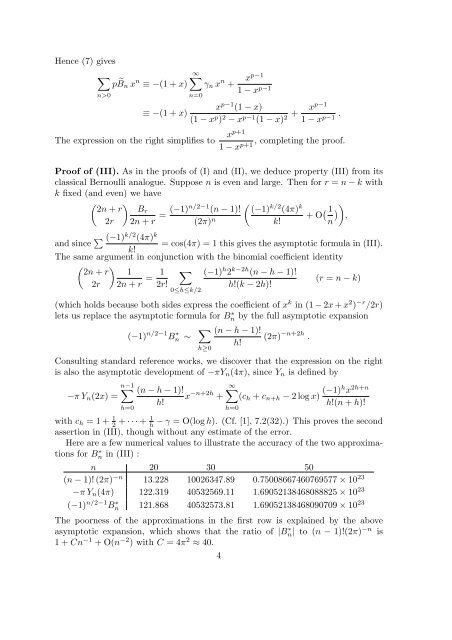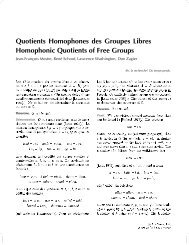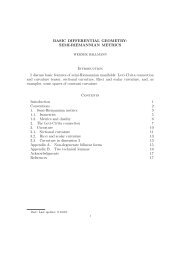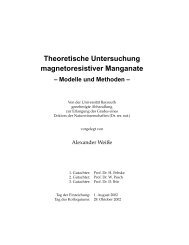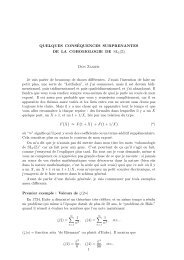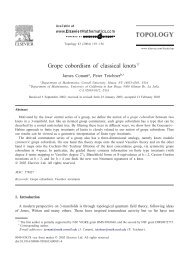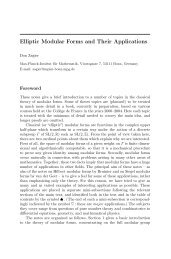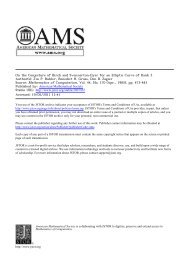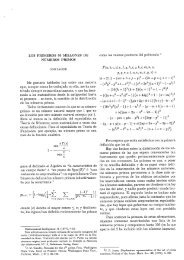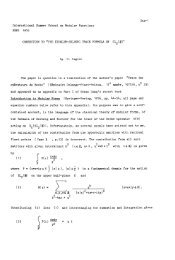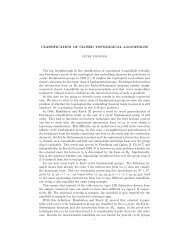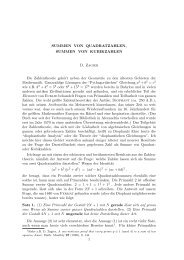A MODIFIED BERNOULLI NUMBER D. Zagier The classical ... - Up To
A MODIFIED BERNOULLI NUMBER D. Zagier The classical ... - Up To
A MODIFIED BERNOULLI NUMBER D. Zagier The classical ... - Up To
Create successful ePaper yourself
Turn your PDF publications into a flip-book with our unique Google optimized e-Paper software.
Hence (7) gives∑∞∑p˜B n x n ≡ −(1+x)n>0≡ −(1+x)n=0<strong>The</strong> expression on the right simplifies toγ n x n + xp−11−x p−1x p−1 (1−x)(1−x p ) 2 −x p−1 (1−x) 2 + xp−11−x p−1 .x p+11−xp+1, completing the proof.Proof of (III). As in the proofs of (I) and (II), we deduce property (III) from its<strong>classical</strong> Bernoulli analogue. Suppose n is even and large. <strong>The</strong>n for r = n−k withk fixed (and even) we have( 2n+r2r)Br2n+r = (−1)n/2−1 (n−1)!(2π) n( (−1) k/2 (4π) kk!+O ( 1) ) ,nand since ∑ (−1)k/2 (4π) k= cos(4π) = 1 this gives the asymptotic formula in (III).k!<strong>The</strong> same argument in conjunction with the binomial coefficient identity( ) 2n+r 12r 2n+r = 1 ∑ (−1) h 2 k−2h (n−h−1)!(r = n−k)2r! h!(k −2h)!0≤h≤k/2(which holds because both sides express the coefficient of x k in (1−2x+x 2 ) −r /2r)lets us replace the asymptotic formula for B ∗ n by the full asymptotic expansion(−1) n/2−1 B ∗ n ∼ ∑ h≥0(n−h−1)!h!(2π) −n+2h .Consulting standard reference works, we discover that the expression on the rightis also the asymptotic development of −πY n (4π), since Y n is defined byn−1∑ (n−h−1)!∞∑−πY n (2x) = x −n+2h + (c h +c n+h −2logx) (−1)h x 2h+nh!h!(n+h)!h=0with c h = 1+ 1 2 +···+ 1 h−γ = O(logh). (Cf. [1], 7.2(32).) This proves the secondassertion in (III), though without any estimate of the error.Here are a few numerical values to illustrate the accuracy of the two approximationsfor Bn ∗ in (III) :n 20 30 50(n−1)!(2π) −n 13.228 10026347.89 0.75008667460769577×10 23−πY n (4π) 122.319 40532569.11 1.69052138468088825×10 23(−1) n/2−1 B ∗ n 121.868 40532573.81 1.69052138468090709×10 23<strong>The</strong> poorness of the approximations in the first row is explained by the aboveasymptotic expansion, which shows that the ratio of |B ∗ n| to (n − 1)!(2π) −n is1+Cn −1 +O(n −2 ) with C = 4π 2 ≈ 40.4h=0


